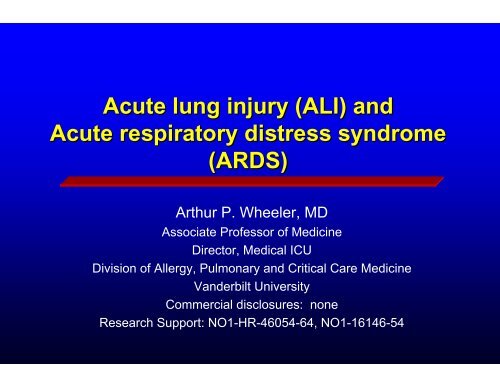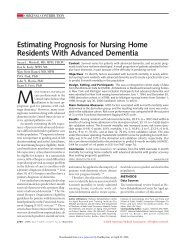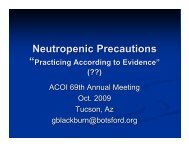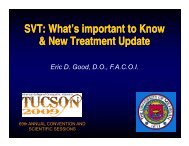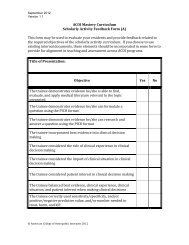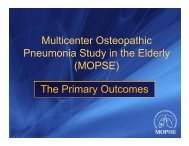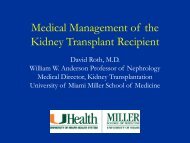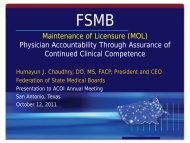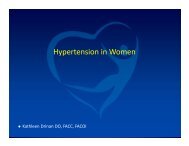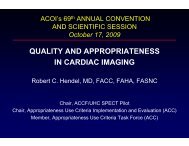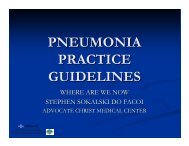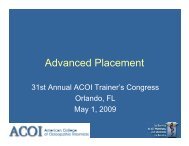Acute lung injury (ALI) and Acute respiratory distress syndrome ...
Acute lung injury (ALI) and Acute respiratory distress syndrome ...
Acute lung injury (ALI) and Acute respiratory distress syndrome ...
You also want an ePaper? Increase the reach of your titles
YUMPU automatically turns print PDFs into web optimized ePapers that Google loves.
<strong>Acute</strong> <strong>lung</strong> <strong>injury</strong> (<strong>ALI</strong>) <strong>and</strong><br />
<strong>Acute</strong> <strong>respiratory</strong> <strong>distress</strong> <strong>syndrome</strong><br />
(ARDS)<br />
Arthur P. Wheeler, MD<br />
Associate Professor of Medicine<br />
Director, Medical ICU<br />
Division of Allergy, Pulmonary <strong>and</strong> Critical Care Medicine<br />
V<strong>and</strong>erbilt University<br />
Commercial disclosures: none<br />
Research Support: NO1-HR-46054-64, NO1-16146-54
• 21 yo female WKU student<br />
• Previously healthy<br />
• Admitted with Gullian-Barre<br />
• Day 5 aspiration-induced ARDS<br />
• Ventilation<br />
– Tidal volume 10 ml/kg<br />
–FiO 2 0.8<br />
– PEEP 15<br />
– PIP 70 cm H 2 0<br />
– Adjustments made to normalize blood gases
• Day 23 bilateral tension<br />
pneumothoraces<br />
– Multiple (4+3) chest tubes<br />
– Large bilateral (R>L) cystic<br />
areas<br />
– Pneumomediastinum<br />
– Interstitial emphysema
• Day 52 air-hunger, suddenly sat upright<br />
– New seizure<br />
– Livedo reticularis right hemi-thorax, h<strong>and</strong>, <strong>and</strong> face<br />
– ECG: acute inferior myocardial infarction<br />
– Head CT: multiple new infarcts<br />
• Day 70 autopsy:<br />
– Severe <strong>lung</strong> <strong>injury</strong> with prominent cystic changes,<br />
extensive fibrosis <strong>and</strong> foci of infection<br />
– Multiple myocardial infarcts, intact atrial septum<br />
– Multiple CNS infarcts c/w emboli<br />
Marini JJ Ann Intern Med 1989; 110: 699
<strong>Acute</strong> <strong>lung</strong> <strong>injury</strong> (<strong>ALI</strong>)<br />
<strong>Acute</strong> <strong>respiratory</strong> <strong>distress</strong> <strong>syndrome</strong><br />
• <strong>Acute</strong> onset<br />
• Profound hypoxemia<br />
• Radiograph of<br />
pulmonary edema<br />
• No evidence of left<br />
atrial hypertension<br />
• “Stiff” or “small” <strong>lung</strong>s<br />
• Predisposing cause<br />
(ARDS)<br />
Bernard GR. Am J Resp Crit Care 1994; 149: 818
Causes of <strong>ALI</strong><br />
Severe<br />
sepsis<br />
26%<br />
Aspiration<br />
15%<br />
Trauma<br />
Pneumonia<br />
11%<br />
35%<br />
Other<br />
13%<br />
ARDS Network N Engl J Med 2000; 342:1301<br />
Drowning<br />
Pancreatitis<br />
Reperfusion<br />
Salicylate <strong>and</strong> narcotic OD<br />
Fat / amniotic fluid embolism<br />
Smoke / chemical inhalation
Mortality rate of <strong>ALI</strong>/ARDS<br />
100<br />
80<br />
Mortality (%)<br />
60<br />
40<br />
20<br />
0<br />
83 84 85 86 87 88 89 90 91 92 93<br />
Milberg J JAMA 1995;273:306
Supportive care for all patients<br />
• DVT prophylaxis<br />
• Gastrointestinal bleeding prophylaxis<br />
• Elevate HOB to 30 degrees<br />
• H<strong>and</strong> washing<br />
• Catheters inserted using full barrier precautions with<br />
chlorhexidine.<br />
• Sedation <strong>and</strong> analgesia protocols.<br />
• Reduction in transfusion thresholds.<br />
• St<strong>and</strong>ardized feeding protocols.<br />
• Contrast nephropathy avoidance.<br />
• Bedsore prevention program.
Causes of death<br />
Multiple<br />
organ failure<br />
Severe<br />
sepsis<br />
Underlying<br />
<strong>injury</strong> /<br />
illness<br />
Lung failure<br />
Montgomery AB Am Rev Respir Dis. 1985;132:485
Epithelial <strong>injury</strong><br />
Protein rich<br />
edema fluid<br />
Inflammatoryhemorrhagic<br />
infiltrate<br />
Increased<br />
vascular<br />
permeability<br />
Adapted from Ware LB, N Engl J Med. 2000; 342:1334<br />
Activated<br />
coagulation
<strong>ALI</strong> is heterogeneous<br />
Near normal<br />
Marginal<br />
Non-functional<br />
Maunder R, JAMA 1986; 255:2463
Major questions in <strong>ALI</strong> in the 1990’s<br />
• What is the best way to ventilate the <strong>lung</strong><br />
• Does attenuating inflammation offer benefit<br />
• What should be done with fluids
ARDSnet<br />
Mass General<br />
Washington<br />
San Francisco<br />
Philadelphia<br />
Baltimore<br />
NHLBI<br />
Utah<br />
Denver<br />
Michigan<br />
V<strong>and</strong>erbillt<br />
Clevel<strong>and</strong><br />
Duke<br />
NIH NHLBI ARDS Clinical Trials Network
Ventilation
Airway pressures<br />
Airway<br />
Pressure<br />
Peak inspiratory<br />
pressure (PIP)<br />
Plateau pressure<br />
PEEP<br />
Time
Mechanisms of ventilation induced<br />
<strong>lung</strong> <strong>injury</strong><br />
• Healthy animals developed <strong>lung</strong> <strong>injury</strong> if ventilated<br />
with PIP > 40 cm H 2 O “Barotrauma”<br />
– Kolobow Am Rev Resp Dis 135:312, 1987<br />
• Identical pressures did not cause <strong>injury</strong> if <strong>lung</strong><br />
expansion was restricted “Volutrauma”<br />
– Hern<strong>and</strong>ez J Appl Physiol 1989 66:2364<br />
• PEEP attenuated the <strong>injury</strong> of high pressure<br />
ventilation “Repetitive opening <strong>injury</strong>”<br />
– Webb Am Rev Resp Dis 1974; 110: 556
Ventilation can cause systemic<br />
inflammation: “biotrauma”<br />
1200<br />
600<br />
1000<br />
500<br />
BAL<br />
TNF<br />
(pg/ml)<br />
800<br />
600<br />
400<br />
BAL<br />
IL-6<br />
(pg/ml)<br />
400<br />
300<br />
200<br />
200<br />
100<br />
0<br />
Control MVHP MVZP HVZP<br />
0<br />
Control MVHP MVZP HVZP<br />
Tremblay J Clin Invest 1997; 99:944
Inadequate<br />
Tidal Volume<br />
or PEEP<br />
Large<br />
Tidal Volume<br />
or Inadequate<br />
PEEP<br />
Consequences:<br />
• Atelectasis<br />
• Hypoxemia<br />
• Hypercapnia<br />
<strong>ALI</strong><br />
Before Ventilation<br />
Consequences:<br />
• V/Q mismatch<br />
TNF<br />
IL-6, etc<br />
• Alveolar-capillary <strong>injury</strong><br />
• “Barotrauma”<br />
• Inflammation
Tidal volume in practice<br />
50<br />
40<br />
Percent of<br />
responders<br />
30<br />
Normal<br />
Recommended<br />
20<br />
10<br />
0<br />
< 5 5-9 10-13 14-17<br />
Tidal volume mL/kg measured body weight<br />
Carmichael L. J Crit Care 1996; 11: 9
Trials of lower tidal ventilation<br />
Mortality (%) Pressure<br />
Traditional “Protective” Limits<br />
Stewart 1 (n = 120) 47 50 PIP=50<br />
Brochard 2 (n = 116) 38 47 PIP=60<br />
Brower 3 (n = 52) 46 50 Pplat 45-55<br />
Amato 4 (n = 53) 71 38<br />
1. NEJM 338:355-361, 1998 2. AJRCCM 158: 1831, 1998<br />
3. CCM 27:1492, 1999 4. NEJM 339: 347, 1998
normal<br />
Hypothesis:<br />
In patients with <strong>ALI</strong>, ventilation with smaller tidal volumes<br />
(6 mL/kg) will result in better clinical outcomes than<br />
traditional tidal volumes (12 mL/kg) ventilation.<br />
ARDS Network N Engl J Med 2000; 342:1301
Ventilator procedures<br />
12 ml/kg Group<br />
•Initial Vt = 12 ml/kg PBW<br />
•If Pplat > 50 cmH 2 0, reduce Vt<br />
•Minimum Vt = 4 ml/kg<br />
6 ml/kg Group<br />
•Initial Vt = 6 ml/kg PBW.<br />
•If Pplat > 30 cmH 2 0, reduce Vt.<br />
•Minimum Vt = 4 ml/kg<br />
24<br />
20<br />
PEEP<br />
16<br />
12<br />
8<br />
4<br />
0<br />
0.3 0.4 0.4 0.5 0.5 0.6 0.7 0.7 0.8 0.9 0.9 0.9 1.0 1.0 1.0<br />
FIO2<br />
PaO 2 = 55 - 80 mmHg or SpO 2 = 88 - 95%<br />
St<strong>and</strong>ardized weaning protocol
Macro-barotrauma is not the<br />
mechanism of <strong>injury</strong><br />
6ml/kg 12 ml/kg<br />
p<br />
Requiring<br />
thoracostomy 13% 12% 0.932<br />
Not requiring<br />
thoracostomy 7% 9% 0.359<br />
ARDS Network N Engl J Med 2000; 342:1301
Effects of lower tidal volume<br />
14<br />
Tidal volume<br />
30<br />
Total <strong>respiratory</strong> rate<br />
Vt<br />
(ml/kg<br />
PBW)<br />
12<br />
10<br />
8<br />
6<br />
6 ml/kg<br />
12 ml/kg<br />
Breaths per<br />
minute<br />
26<br />
22<br />
18<br />
4<br />
0 1 2 3 4<br />
Study Day<br />
14<br />
0 1 2 3 4<br />
Study Day<br />
35<br />
Plateau pressure<br />
45<br />
Arterial PaCO2<br />
30<br />
cm water<br />
25<br />
20<br />
PaCO2 40<br />
(mm Hg)<br />
35<br />
15<br />
0 1 2 3 4<br />
Study Day<br />
ARDS Network N Engl J Med 2000; 342:1301<br />
30<br />
0 1 2 3 4<br />
Study Day
PaO 2 / FiO 2<br />
180<br />
160<br />
*<br />
*<br />
P/F<br />
140<br />
120<br />
ARDS Network N Engl J Med 2000; 342:1301<br />
6 ml/kg<br />
12 ml/kg<br />
0 1 2 3 4<br />
Study Day
Median ventilator<br />
free days<br />
7 days p=0.005<br />
Hospital mortality<br />
9 % ARR p=0.0054<br />
ARDS Network N Engl J Med 2000; 342:1301
Median organ failure free days<br />
CNS<br />
Hepatic<br />
*<br />
Cardiovascular<br />
*<br />
Coagulation<br />
*<br />
= 6 ml/kg<br />
= 12 ml/kg<br />
Renal<br />
ARDS Network N Engl J Med 2000; 342:1301<br />
0 7 14 21 28<br />
Days<br />
*
0<br />
6 mL/kg 12 mL/kg<br />
-20<br />
Percent change<br />
Day 0 to 3<br />
-40<br />
-60<br />
-80<br />
IL-6 IL-8 IL-10<br />
-100<br />
Crit Care Med. 2005;33:1<br />
P=0.001 between groups
Tidal volume as a risk factor for <strong>ALI</strong><br />
Baseline Vt 2001 Risk of developing <strong>ALI</strong><br />
♂=10.4 mL/kg<br />
♀=11.4 mL/kg<br />
Gajic O. Crit Care Med 2004, 32:1817<br />
OR 1.29 /mL Vt >6 PBW<br />
(1.12-1.51)
“Lung protective” ventilation<br />
V<br />
Add PEEP<br />
o<br />
l<br />
u<br />
m<br />
e<br />
<br />
12 ml/kg PBW<br />
Pressure<br />
Limit Distending<br />
Pressure
Hypothesis:<br />
In patients with <strong>ALI</strong> ventilated with 6 mL/kg, higher<br />
levels of PEEP will result in better clinical outcomes<br />
than lower levels of PEEP.<br />
N Engl J Med 2004; 351:327
Ventilation strategy<br />
PEEP<br />
•All given 6 mL/kg PBW tidal volume<br />
•Oxygenation: SpO 2 = 88 - 95% or PaO 2 = 55 - 80 mm Hg<br />
•St<strong>and</strong>ardized weaning<br />
24<br />
20<br />
16<br />
12<br />
8<br />
4<br />
0<br />
0.3 0.3 0.4 0.4 0.5 0.5 0.6 0.7 0.7 0.7 0.8 0.8 0.9 0.9 0.9 1.0 1.0 1.0 1.0<br />
N Engl J Med 2004; 351:327<br />
FIO2
Barotrauma<br />
20<br />
15<br />
Low PEEP<br />
High PEEP<br />
P=0.51<br />
Percent<br />
10<br />
5<br />
267 270<br />
0<br />
New Barotrauma<br />
N Engl J Med 2004; 351:327
Vt (ml/kg)<br />
9<br />
8<br />
7<br />
6<br />
Physiology of higher / lower PEEP<br />
Tidal volume<br />
Low PEEP<br />
High PEEP<br />
Pplat (mm Hg)<br />
28<br />
27<br />
26<br />
25<br />
24<br />
Pplat<br />
5<br />
16<br />
0 1 2 3 4 7<br />
PEEP<br />
23<br />
0.65<br />
0 1 2 3 4 7<br />
FIO2<br />
Low PEEP<br />
PEEP<br />
14<br />
12<br />
10<br />
FIO2<br />
0.60<br />
0.55<br />
0.50<br />
0.45<br />
High PEEP<br />
8<br />
0.40<br />
6<br />
0 1 2 3 4 7<br />
0 1 2 3 4 7<br />
Study day<br />
0.35<br />
N Engl J Med 2004; 351:327<br />
Study day
Physiology of higher / lower PEEP<br />
PaO2 / FIO2 ratio<br />
PaCO2<br />
210<br />
50<br />
190<br />
45<br />
P/F Ratio<br />
170<br />
PaCO2<br />
40<br />
150<br />
35<br />
Low PEEP<br />
High PEEP<br />
130<br />
0 1 2 3 4 7<br />
Study day<br />
30<br />
1 2 3 4 7<br />
Study day<br />
N Engl J Med 2004; 351:327
Hospital mortality<br />
25% low vs 28% high p=0.48<br />
Higher PEEP<br />
Lower PEEP<br />
Median ventilator free days<br />
14.5 low vs 13.8 high p=0.51<br />
N Engl J Med 2004; 351:327
Median organ failure free days<br />
Renal<br />
P=0.74<br />
Coagulation<br />
P=0.90<br />
Hepatic<br />
P=0.72<br />
Cardiovascular<br />
P=0.68<br />
CNS<br />
P=0.25<br />
0 7 14 21 28<br />
Low PEEP<br />
High PEEP<br />
N Engl J Med 2004; 351:327
“Lower tidal volume with 6 cc per kilo decreased mortality<br />
from 40% to 31%. You twirl a knob, you’re ‘gonna save a<br />
life..OK…”
Summary<br />
• Lower tidal volumes reduce death rates compared to<br />
“traditional” tidal volumes.<br />
• Patients on higher tidal volumes look more comfortable<br />
(until they die).<br />
• In the range tested higher PEEP is not “better” or<br />
“worse” than lower PEEP.<br />
• Lower tidal volumes may prevent <strong>ALI</strong> development.
Treating inflammation
Ketoconazole for Early Treatment of <strong>Acute</strong> Lung Injury <strong>and</strong> <strong>Acute</strong><br />
Respiratory Distress Syndrome: A R<strong>and</strong>omized Controlled Trial<br />
The NIH NHLBI ARDS Network<br />
JAMA 2000;283:1995-2002.
Crit Care Med. 2002;30:1-6.
RCT of Steroids for persistent ARDS<br />
• ARDS x 7 d with LIS > 2.5<br />
• R<strong>and</strong>omized (2:1) to<br />
steroids vs. placebo<br />
– MPS 2 mg/kg load then<br />
– 2 mg/kg/d x 14 d then<br />
– 1 mg/kg/d x 7 d then<br />
– 0.5 mg/kg/d x 7 d etc to 32 d<br />
• Improvement = LIS by 1<br />
• If no improvement at 10d,<br />
crossed over<br />
Placebo 8<br />
2 died<br />
2 improved<br />
4 cross-overs<br />
24 r<strong>and</strong>omized<br />
MPS 16<br />
16<br />
Meduri U. JAMA 1998; 280:159
Mortality outcomes<br />
Placebo MPS p value<br />
• Intention to Rx 5/8 (62%) 2/16 (12%) 0.03<br />
• As treated 2/4 (50%) 5/20 (25%) NS<br />
Meduri U. JAMA 1998; 280:159
• R<strong>and</strong>omized, blinded controlled trial of<br />
methylprednisilone vs. placebo for <strong>ALI</strong><br />
persisting > 7 days<br />
– 2 mg/kg/day x 14 days; then 1 mg/kg/day x 7<br />
days then tapered over 4 days.<br />
N Engl J Med. 2006 20;354:1671-84
Methylprednisilone vs. placebo results<br />
N Engl J Med. 2006 20;354:1671
Summary<br />
• With the exception of human recombinant<br />
activated protein C for severe sepsis, no antiinflammatory<br />
strategy has improved mortality<br />
in <strong>ALI</strong>.
Fluid therapy <strong>and</strong><br />
monitoring catheters
Is a PA catheter harmful or helpful <br />
• Prospective cohort study of the association<br />
between PAC (inserted ICU day 1) <strong>and</strong> survival,<br />
LOS, cost.<br />
• “Propensity score” to adjust for covariates.<br />
• PAC recipients matched with patients with same<br />
disease category <strong>and</strong> propensity score who did<br />
not get PAC.<br />
Connors A, JAMA 1996; 276:889-897
Evidence the PAC may be harmful<br />
Relative Hazard of Death:<br />
Patients (n)<br />
All (5735)<br />
ARF (1789)<br />
MOF (2480)<br />
CHF (456)<br />
Others* (1010)<br />
Odds Ratio (95% CI)<br />
1.21 (1.09-1.25)<br />
1.30 (1.05-1.61)<br />
1.32 (1.11-1.57)<br />
1.02 (0.55-1.89)<br />
1.06 (0.80-1.41)<br />
p<br />
< 0.001<br />
< 0.001<br />
< 0.001<br />
ns<br />
ns<br />
* (severe COPD, cirrhosis, nontraumatic coma, etc)<br />
Connors A. JAMA 1996; 276:889-897
Effectiveness of PAC in the initial care<br />
of the critically ill<br />
Mortality (30-day)<br />
ICU LOS (days)<br />
Total Costs<br />
PAC (n=1008)<br />
37.5%<br />
14.8<br />
$49,300<br />
No PAC (n=1008)<br />
32.8% p = 0.003<br />
13.0 p < 0.001<br />
$35,700 p < 0.001<br />
Connors A. JAMA 1996; 276: 889-897
FACTT trial objectives<br />
To evaluate the mortality <strong>and</strong> morbidity<br />
effects of:<br />
• PAC versus CVC management<br />
<strong>and</strong><br />
• “Fluid conservative” vs. “fluid liberal”<br />
management
FACTT: Factorial trial design<br />
C<br />
A<br />
T<br />
H<br />
E<br />
T<br />
E<br />
R<br />
PAC<br />
(n = 500)<br />
CVC<br />
(n = 500)<br />
Fluid Management<br />
“Conservative”<br />
(n = 500)<br />
“Liberal”<br />
(n = 500)<br />
250 patients 250 patients<br />
250 patients 250 patients
FACTT: Treatment principles<br />
• Evaluate MAP, UOP, CI, exam <strong>and</strong> CVP or PAOP <<br />
every 4 hours<br />
• Hypotension: correct as fast as possible using any<br />
combination of any fluid <strong>and</strong> vasopressor.<br />
• Oliguria treatment:<br />
– Fluid - if CVP or PAOP low or low-normal<br />
– Furosemide - if CVP or PAOP high/high-normal<br />
• Ineffective circulation (low cardiac output) treatment:<br />
– Fluid - if CVP or PAOP low or low-normal<br />
– Dobutamine - if CVP or PAOP high/high-normal
FACTT: Treatment principles<br />
• If hypotension, oliguria <strong>and</strong> ineffective circulation<br />
are absent or resolved:<br />
– <strong>and</strong> CVP or PAOP is abnormally high give<br />
incremental furosemide.<br />
– <strong>and</strong> CVP or PAOP is within the “normal range”<br />
give fluid or diuretics to separate patients into<br />
two “normal” pressure ranges (liberal <strong>and</strong><br />
conservative).
Intravascular<br />
Pressure<br />
(PAOP/CVP)<br />
>> Normal<br />
Low MAP<br />
Acceptable MAP off vasopressors<br />
Low UOP<br />
low flow nl flow<br />
Dobutamine<br />
Lasix<br />
Lasix<br />
Acceptable UOP<br />
low flow nl flow<br />
Dobutamine<br />
Lasix<br />
Lasix<br />
> Normal<br />
High normal<br />
Vasopressor<br />
Fluids<br />
Dobutamine<br />
Fluid<br />
Lasix<br />
Fluid<br />
Dobutamine<br />
Fluid<br />
Lasix<br />
Cons.<br />
Lasix<br />
Low normal<br />
Fluid<br />
Fluid<br />
Fluid<br />
Liberal<br />
Fluid
Conservative fluid strategy<br />
Furosemide<br />
UOP < 0.5 ml/kg/h &<br />
CVP or PAOP low<br />
MAP < 60 mmHg<br />
Low flow by exam or CI
Liberal fluid strategy<br />
Fluids<br />
FiO2 > 0.7<br />
CI > 4.5<br />
LUNG<br />
CVP 10-14<br />
14<br />
PAOP 14-18<br />
18<br />
Favors<br />
Perfused<br />
KIDNEY<br />
(organs)
FACTT: outcome variables<br />
Primary<br />
Mortality prior to hospital discharge to day 60<br />
Secondary (major)<br />
Ventilator - free days to day 28<br />
Organ - failure - free days to day 28
11,512 Met <strong>ALI</strong> Criteria<br />
1,001 R<strong>and</strong>omized<br />
1 Lost f/u<br />
Exclusions:<br />
•21% PAC<br />
•16% MD refusal<br />
•14% Chronic Lung Disease<br />
•11% Lethal underlying Disease<br />
•9% Dialysis<br />
•8% Time window<br />
•8% Severe liver Disease<br />
1,000 Entered Trial<br />
PAC Lib CVC Lib PAC Cons CVC Cons
N Engl J Med 2006; 354: 2213
Enrollment <strong>and</strong> outcomes<br />
1001 R<strong>and</strong>omized<br />
513 assigned to PAC<br />
501 received PAC<br />
12 not inserted<br />
5 withdrew consent<br />
5 exclusions discovered<br />
1 died before placement<br />
1 heart<br />
0 Lost<br />
block<br />
to follow<br />
during<br />
up<br />
insertion<br />
488 assigned to CVC<br />
487 received CVC<br />
7 crossovers 1 day 0<br />
2 day 1<br />
1 day 2<br />
1 withdrew 2 day consent 3<br />
1 day 6<br />
513 analyzed<br />
487 analyzed
Baseline demographics<br />
Characteristic<br />
Age<br />
Female (%)<br />
Primary <strong>lung</strong> <strong>injury</strong> (%)<br />
– Pneumonia<br />
– Severe sepsis<br />
– Aspiration<br />
– Trauma<br />
– Other<br />
Medical ICU (%)<br />
N Engl J Med 2006; 354: 2213<br />
PAC<br />
CVC p value<br />
50+1 50+1 0.81<br />
46 47 0.89<br />
0.81<br />
48 46<br />
23 24<br />
15 15<br />
8 7<br />
7 8<br />
66 66 0.91
Baseline severity of illness<br />
Characteristic<br />
APACHE III<br />
Shock (%)<br />
Pre-study fluid intake (L/24 h)<br />
PAC<br />
CVC p value<br />
95+1 94+1 0.55<br />
37 32 0.06<br />
4.9+0.2 4.9+0.2 0.99<br />
Tidal volume (ml/kg PBW)<br />
PEEP (cm H 2 O)<br />
PaO 2 /FIO 2<br />
Plateau pressure (cm H 2 0)<br />
7.4+0.1 7.4+0.1 0.88<br />
9.3+0.2 9.7+0.2 0.09<br />
159+3 151+3 0.10<br />
26.2+0.4 26.2+0.4 0.93<br />
N Engl J Med 2006; 354: 2213
Timing of protocol initiation<br />
Time to first protocol<br />
instruction (hours)<br />
ICU admission<br />
<strong>ALI</strong> qualification<br />
R<strong>and</strong>omization<br />
PAC CVC p value<br />
44.4+2 40.8+3 0.23<br />
25.2+0.7 23.0+0.6 0.02<br />
3.5+0.1 2.2+0.1
Instructions <strong>and</strong> compliance<br />
PAC<br />
CVC p value<br />
Instructions per day<br />
Instructions followed (%)<br />
4.8+0.1 4.4+0.1 0.03<br />
91+1 88+1 0.12<br />
N Engl J Med 2006; 354: 2213
Catheter use <strong>and</strong> complications<br />
Complications per catheter<br />
0.1<br />
0.05<br />
0<br />
3<br />
2<br />
1<br />
0.08<br />
P=0.35<br />
0.06<br />
PAC<br />
CVC<br />
Total catheters per patient<br />
2.47<br />
P
42 7
Positive blood cultures<br />
20<br />
15<br />
p=0.43<br />
Percent of<br />
patients<br />
10<br />
5<br />
PAC<br />
CVC<br />
0<br />
Any 1 2 >2<br />
Number of positive cultures<br />
N Engl J Med 2006; 354: 2213
No differences between PAC <strong>and</strong> CVC in:<br />
• Blood pressure<br />
• Heart rate<br />
• CVP<br />
• Net fluid balance<br />
• Vasopressor use<br />
• Tidal volume<br />
• PEEP<br />
• Plateau pressure<br />
• Oxygenation measures<br />
N Engl J Med 2006; 354: 2213
Proportion of assessments in shock after<br />
0.50<br />
entry<br />
0.40<br />
0.30<br />
PAC<br />
CVC<br />
0.20<br />
0.10<br />
0.00<br />
Shock Free<br />
Shock<br />
Engl J Med 2006; 354: 2213-2224<br />
Baseline shock status
1.6<br />
Creatinine<br />
(mg/dL)<br />
1.2<br />
0.8<br />
0.4<br />
Renal replacement therapy<br />
PAC 14 % vs. CVC 11% p=0.15<br />
Blood urea<br />
nitrogen<br />
(mg/dL)<br />
35<br />
30<br />
25<br />
PAC<br />
CVC<br />
N Engl J Med 2006; 354: 2213<br />
20<br />
0 1 2 3 4 5 6 7<br />
Study Day
11.0<br />
Hemoglobin<br />
(gm/dL)<br />
10.5<br />
10.0<br />
9.5<br />
PAC<br />
CVC<br />
9.0<br />
0 1 2 3 4 5 6 7<br />
Study Day<br />
Patients<br />
transfused to day 7<br />
(percent)<br />
Percent<br />
40<br />
30<br />
20<br />
38<br />
P
Kaplan Meier estimates of survival<br />
<strong>and</strong> unassisted breathing<br />
Mortality to day 60<br />
PAC 27.4% vs. CVC 26.3%<br />
P=0.69 CI -4.4 to 6.6%<br />
Ventilator-free days to day 28<br />
PAC 13.2+0.5 vs. CVC 13.5+0.5<br />
P=0.58
Organ failure free days to day 28<br />
Renal<br />
Hepatic<br />
Coagulation<br />
CNS<br />
0 2 4 6 8 10 12 14 16 18 20 22 24 26 28<br />
PAC CVC N Engl J Med 2006; 354: 2213
Summary<br />
• Using the data from a PAC compared to that<br />
from a CVC in an explicit protocol:<br />
– Did not alter survival.<br />
– Did not improve organ function.<br />
– Did not change outcomes for patients entering in<br />
shock compared to those without shock.<br />
• PAC use resulted in more non-fatal<br />
complications, mostly arrhythmias.<br />
N Engl J Med 2006; 354: 2213
SICU mortality <strong>and</strong> PAC use<br />
40<br />
1<br />
Percent PAC use<br />
35<br />
30<br />
25<br />
20<br />
15<br />
10<br />
5<br />
0.9<br />
0.8<br />
0.7<br />
0.6<br />
0.5<br />
0.4<br />
0.3<br />
0.2<br />
0.1<br />
PAC Use<br />
O/E mortality<br />
0<br />
0<br />
'98 '99 '00 '01 '02 '03 '04 '05 '06<br />
Brunswold M Crit Care Med 2007;34:A55
N Engl J Med. 2006;354:2564
Frequency of diuretic <strong>and</strong> fluid bolus<br />
therapies<br />
0.5<br />
P
Cumulative furosemide dose<br />
1200<br />
1000<br />
Liberal<br />
Conservative<br />
800<br />
mg<br />
600<br />
400<br />
200<br />
0<br />
0 1 2 3 4 5 6 7<br />
N Engl J Med. 2006;354:2564<br />
Study Day
8000<br />
Net fluid balance<br />
ml of fluid<br />
6000<br />
4000<br />
2000<br />
0<br />
-2000<br />
40<br />
0 1 2 3 4 5 6 7<br />
Vasopressor use<br />
N Engl J Med. 2006;354:2564<br />
P=0.25<br />
Percent<br />
30<br />
20<br />
10<br />
0<br />
Prer<strong>and</strong><br />
Prefluid<br />
1 2 3 4 5 6 7<br />
Study Day<br />
Liberal<br />
Conservative
Cumulative fluid balance<br />
ml of fluid<br />
8000<br />
6000<br />
4000<br />
2000<br />
Liberal<br />
Conservative<br />
6 ml TV (1996-1999)<br />
PEEP (1999-2002)<br />
0<br />
0 1 2 3 4 5 6 7<br />
-2000<br />
N Engl J Med. 2006;354:2564<br />
Study Day
Cumulative fluid balance at day 7:<br />
Baseline shock vs. no shock<br />
12000<br />
ml of fluid<br />
9000<br />
6000<br />
3000<br />
Liberal<br />
Conservative<br />
6863 ml<br />
7234 ml<br />
0<br />
-3000<br />
N Engl J Med. 2006;354:2564<br />
Shock free<br />
Baseline<br />
Shock
CVP separation<br />
13<br />
12<br />
11<br />
10<br />
9<br />
8<br />
Liberal<br />
Conservative<br />
Prer<strong>and</strong><br />
Prefluid<br />
1 2 3 4 5 6 7<br />
Study Day<br />
N Engl J Med. 2006;354:2564
PAOP separation<br />
17<br />
16<br />
PAC Liberal<br />
PAC Conservative<br />
PAOP<br />
15<br />
14<br />
13<br />
12<br />
Prefluid<br />
N Engl J Med. 2006;354:2564.<br />
1 2 3 4 5 6 7<br />
Study Day
Proportion of assessments in shock after<br />
entry<br />
0.50<br />
0.40<br />
Liberal<br />
Conservative<br />
0.30<br />
0.20<br />
0.10<br />
0.00<br />
Shock Free<br />
Shock<br />
N Engl J Med. 2006;354:2564<br />
Baseline shock status
Tidal volume<br />
(mL/kg PBW)<br />
8.00<br />
7.00<br />
6.00<br />
5.00<br />
Conservative<br />
Liberal<br />
PEEP<br />
(cm H 2 O)<br />
N Engl J Med. 2006;354:2564<br />
4.00<br />
10.0<br />
9.0<br />
8.0<br />
7.0<br />
6.0<br />
0 1 2 3 4 7<br />
p=0.008<br />
0 1 2 3 4 7<br />
Study Day
200<br />
190<br />
Conservative<br />
Liberal<br />
PaO 2 / FiO 2<br />
14<br />
12<br />
Oxygenation index<br />
180<br />
170<br />
10<br />
160<br />
150<br />
P=0.07<br />
0 1 2 3 4 7<br />
8<br />
6<br />
P=0.003<br />
1 2 3 4 7<br />
On study plateau pressure<br />
Murray <strong>lung</strong> <strong>injury</strong> score<br />
27<br />
26<br />
P=0.002<br />
2.75<br />
2.50<br />
P < 0.001<br />
25<br />
2.25<br />
24<br />
2.00<br />
23<br />
0 1 2 3 4 7<br />
1.75<br />
0 1 2 3 4 7<br />
Study Day<br />
Study Day
Respiratory rate<br />
PaCO2<br />
30<br />
48<br />
46<br />
28<br />
44<br />
26<br />
42<br />
24<br />
Liberal<br />
Conservative<br />
1 2 3 4 7<br />
40<br />
38<br />
0 1 2 3 4 7<br />
13<br />
Minute ventilation<br />
7.43<br />
pH<br />
12<br />
7.41<br />
11<br />
7.39<br />
7.37<br />
10<br />
1 2 3 4 7<br />
Study Day<br />
7.35<br />
0 1 2 3 4 7<br />
Study Day
Survival to hospital discharge <strong>and</strong> breathing<br />
without assistance to day 60<br />
Mortality: Liberal 28.4% vs.<br />
Conservative 25.5% p = 0.30<br />
Median ventilator free days<br />
Liberal 14.6 vs. Conservative 12.1<br />
p = 0.002
ICU free days to day 28<br />
Conservative<br />
13.4<br />
P
Organ failure free days to day 28<br />
Renal<br />
Hepatic<br />
Coagulation<br />
CNS<br />
P=0.025<br />
0 4 8 12 16 20 24 28<br />
Conservative<br />
Liberal<br />
N Engl J Med. 2006;354:2564
Dialysis to Day 60<br />
Renal support<br />
Conservative Liberal P value<br />
Patients (%) 10 14 0.06<br />
Days 11.0 + 1.7 10.9 + 1.4 0.96<br />
N Engl J Med. 2006;354:2564
Hemoglobin<br />
(gm/dL)<br />
11.0<br />
10.5<br />
10.0<br />
9.5<br />
9.0<br />
Liberal<br />
Conservative<br />
0 1 2 3 4 5 6 7<br />
Study Day<br />
P
Frequency of metabolic abnormalities<br />
Abnormality<br />
K < 3.0<br />
K < 2.5<br />
Na > 150<br />
Na increase > 10<br />
HCO 3 > 40<br />
Conservative Liberal p value<br />
(Percent of patients)<br />
26 22 < 0.001<br />
4 3 0.23<br />
25 18 0.0088<br />
28 23 0.0810<br />
6 2 0.0005
Summary<br />
• Conservative patients had better <strong>lung</strong> <strong>injury</strong> scores,<br />
oxygenation index <strong>and</strong> lower PEEP <strong>and</strong> plateau pressures.<br />
• Conservative patients had lower MAP, SV, <strong>and</strong> CI.<br />
• No difference in heart rate, SvO 2 , proportion of protocol<br />
reassessments in shock, percentage receiving<br />
vasopressors.<br />
• The conservative strategy had higher BUN, but there was<br />
no difference in creatinine, renal failure free days, dialysis<br />
use or duration.<br />
N Engl J Med. 2006;354:2564
Conclusions<br />
• Use a normal tidal volume.<br />
• Use a level of PEEP you like.<br />
• Corticosteroids improve oxygenation not survival.<br />
• Routine use of a PAC should be avoided.<br />
• Application of a fluid conservative protocol after<br />
shock resolution improves physiology <strong>and</strong><br />
shortens time on ventilator.
ARDSnet<br />
FACTT: Acknowledgements


